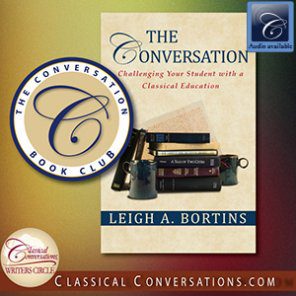“If we want them to become lifelong learners, we should encourage them to begin having conversations with the author” (Leigh Bortins, The Conversation, 61).
Even though my son is in high school and a full blown teenager, I still read to him every night at bedtime. Part of me loves this sweet ritual, but truly after a bone-tiring day, sometimes the last thing I want to do is read. We do not do the nightly reading thing because it is nice; we do it because our day does not feel complete without it. Seriously, I never intended to make it a requirement of our day. Somehow reading before bed together became as essential as putting on our pajamas and brushing our teeth.
As a result, I treasure walking down an aisle in a bookstore or library shelf and recalling sweet memories of times spent together in books. In The Conversation Leigh Bortins makes an important point that one of the few things we truly need in order to educate classically are great books. Further, this rich connection through reading is something that is available to all of us.
“As classical educators and parents, we sometimes forget that we really only need four things to educate someone. We need pencil, paper, good books and time for great conversations” (53).
Get Ready for an Experience
As homeschoolers, we have a secret advantage that I think we often forget. Not only can we dive deep into a subject, but we have the gift of time. We have time to pursue passions in learning, and the chance to make it a true experience. Yes, we may sometimes have busy schedules, but unlike teachers in other forms of schooling, we have the privilege of teaching and modeling learning for our students over a lifetime rather than for a semester or a single school year. We also have the ability to adjust our schedules at any time if we find that we have over-committed and no longer have time for reading, contemplation, and conversation. When it comes to reading and books, there are a million ways to make the learning memorable from popcorn discussion parties, Netflix watching after reading the book, audiobooks for family travels, attending a theater performance or memorizing portions for acting out the book.
I have been thinking about the fact that I have only a handful of years left at home with my son. I do not want to just check off another book from the high school reading list. I want the book to be a vivid experience that my child remembers and shares as a favorite memory from these fleeting days. This may be an ambitious goal and it may not work all the time, but it certainly makes for a joy-filled intention.
Putting the Five Canons of Rhetoric to Work with Reading
As part of our discussion of the book The Conversation we have been looking at how we can use the Five Canons of Rhetoric with any subject. In this article, we will take a look at how we might apply these tools to reading and discussing books at home. (If you need a refresher on the Five Canons, you may read the previous article called “Drawing Out the Wonder” here.
Invention – What is the main argument?
It is tempting to start off a conversation about a book with the question, “Did you like it?” But this is probably the worst question to ask because it invites a dead end response. By instead asking your students about the author’s argument, you are essentially helping them to think bigger about the book. By looking at it through this lens, we are trying to understand the characters, their motivations, and whether or not they changed us, as readers, in the process.
Arrangement – How is the argument structured?
I have to admit I had not always known that the way a story is told is significant. I thought the author wrote the story and that was that. But we can learn much by inviting our students to look beyond the facts of an argument into its structure. By asking our students to look at how the writer organized the storytelling, we are engaging them at a level deeper than the mere facts. Does the author tell the story in chronological order? Does it start at the present and drop back in time? Does the way the story is presented influence or persuade us? By looking at arrangement, we invite our students to step outside the story and think critically about how it influences them as a reader.
Elocution – How is the argument presented?
For me, this is the almost magical part of reading and the most fun aspect of discussing books. These are the gems you come across in language, style, tone, and storytelling. Start by inviting your students to share their favorite passages of the book. Go deeper in your discussion to ask students what they think the author was setting out to do with the manner in which he told the story. Invite them to unearth the tools the author used to weave his story like word choice, symbolism, metaphor, and tone. Help them to see how the individual parts working together paint a vivid picture for the reader.
Memory – What memories should this book retrieve?
If a book is a quality experience, it should leave its readers with a memory, an impression, a favorite passage that lingers and remains with them. Sometimes the best way to stimulate this response in our students is by contrasting it with other great books we have read together, the Bible, or life experiences. Memorizing key passages of the book or committing favorite lines to copy work are also excellent ways to make stories a part of our memory. I think the best question about memory might be, “How does this book become part of you and what you are learning?”
Delivery – What can reading aloud teach me about this book?
Have you ever experienced a book transformed just by hearing it read or reading it out loud? Lately, we have been listening to To Kill a Mockingbird read by Sissy Spacek. The way her liquid, southern drawl carries the story along makes me feel like I have been picked up and plopped down in the 1920s fictional city of Macomb, Alabama. Witnessing stories performed in a dramatic way is another way to bring the story to life. I recently watched several Challenge students perform scenes from Shakespeare. Even though they were amateurs, the story took on new feeling and meaning when acted out. When considering the delivery, think about how the presentation manner changes the experience for the reader. To go beyond this idea, invite your students to consider how they might apply this new experience to their life.
Thinking and Reading Deeply with the Five Canons
Looking through the questions posed by the Five Canons of Rhetoric, we may be asking questions of our students that they do not know how to answer. Better yet, we may ask questions that we do not know how to answer. That is the point. We are able to provoke conversations within our home school that go beyond, “Did you like it?” We are asking our students to dive deep and consider more than simply the literary analysis of theme, plot, characters, and summary. Our goal is to set out a lavish feast of ideas and allow our students to appreciate books in a rich way. Our aim is to create lifelong impressions and experiences that change them forever. It might be a big, fat, lofty goal in our reading to seek out these kinds of conversations. But the end result of creating deep thinkers is worth it.
Read Along in The Conversation
Read Chapter Three – “Reading”
Good Questions:
- How does your family engage together in reading?
- What have you found is the best way to connect with your students in their reading pursuits?
- How are you creating memories in your reading endeavors?
- What could you do to make the next book your child studies a memorable experience?
- What are some ways to try to extend the reading experience beyond the pages? Watching a movie about the book? Going to a play? Memorizing favorite passages? Sketching a piece of art to represent the story line? Hosting a student book discussion gathering? Consider finding a way to create a deep memory with books this season.




